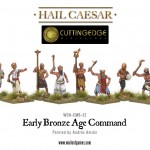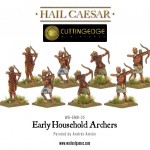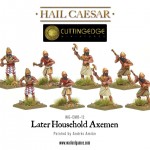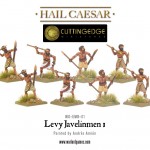Last week Ancients wargaming expert Nigel Stillman provided a detailed account of Early Bronze age warfare and focused on military development in the region. Here, in part 2, Nigel explains how armies were raised and organised.
Raising an Army
The city and its surrounding territory, in other words the city state, was considered to be owned by the patron god of that city. If two cities went to war over land it was also a quarrel between their respective gods. Indeed the god would be consulted about whether or not to go to war or not. Also consulted was the council of elders. The elders would vote or agree on the matter, and perhaps they would have originally appointed the Lugal or war leader, before this position turned into hereditary kingship. Hereditary kingship was not the rule everywhere or at all times, since rulers could arise from various origins.
The entire resources of the city-state, or at least most of them including its manpower, were at the disposal of the city’s god and therefore also the Ensi (high priest governor) or the Lugal (king, warlord). Manpower could be conscripted on a rota basis for a period of state duty, which might take the form of labour or military service. The Lugal and his military scribes would select the best men from the levy for military service. These augmented the Lugal’s own household contingent, which amounted to the regular standing army of the city. Full time soldiers were called Aga-ush, whereas a less specific term for troops or levies including men doing work duty or militia duty was Erin. The Aga-ush included high-ranking officers, unit leaders and various city guards as well as soldiers. These military specialists would form the core of the expanded army and train the militia recruits. Among the duties that could be assigned to Aga-ush soldiers, aside from fighting in battle, were patrolling the routes against raiders, acting as messengers and operating as sailors (or rowers?) of the transport ships. Ships were needed to transport armies up and down the Tigris and Euphrates or even across the Persian Gulf to Magan or Awan (to the east of Elam.)
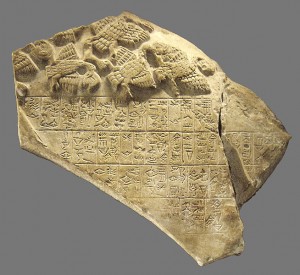
Tactical Organisation of an Army
Over and over again the records refer to units of 10, 60, 600 or 5000 men. The Stela of the Vultures depicts the serried ranks of a Sumerian close formation infantry unit. This is often referred to as a ‘phalanx’ by analogy with the later similar formations of classical times. These soldiers appear to be in a column of six ranks and ten files, advancing with spears levelled towards the enemy. The ancient sculptor of the relief carving has tried hard in his composition to demonstrate that the spears are long enough for six ranks to protrude in front of the big shields carried by those at the front of the formation. Maybe the Lugal Eannatum himself briefed the sculptor because he was proud of the methods of war that had brought him victory – future generations take note… this is how it’s done! Long spears are mentioned in the records that list weapons issued to troops. Therefore this may be a representation of the basic unit of a Sumerian army – a company of 60 soldiers. This calls to mind the Roman republican ‘maniple’ of 60 Legionaries and the Ancient Egyptian basic unit of 40 men depicted by model soldiers from an Old Kingdom tomb. Later on, the Egyptians and most other countries had a basic unit of 50 men, but the Sumerians favoured a Sexigismal numbering system alongside a decimal system.
The ranks of military officers known from the records indicate the hierarchy of military units. The Ugula was a sort of NCO who led a squad of 10 men. Six squads of ten made up the 60 man unit commanded by an Ugula geshda (commander-of-60). Several units of 60 made up a brigade of up to 600 men, commanded by a Nubanda. Larger units, such as the entire household troops of a king, numbered around 5000, commanded by a Shagina (general). This would have included brigades and companies of all kinds of troops- the Sumerian equivalent to a ‘legion’ perhaps. A large army (texts indicate 10,000 or 20,000 for Akkadian or Ur empire armies) might have two or more such ‘divisions’ especially if representing the combined army of allied cities or an empire. A single city probably had a small army of up to 5000 including the full militia. The scribes would need a reliable military organisation in place so as to calculate rations and supplies and replenish units with recruits. The actual unit strengths would vary on campaign, of course.
How did the chariotry, or rather the battle-carts, fit into this organisation? The inscriptions of the war between Lagash and Umma may give a clue. When Umma was defeated in battle, 60 of the city’s elite troops were cornered as they retreated from pursuing Lagashites. They ran up against an irrigation canal and were caught, resulting in five heaps of slain Ummaites to feed the vultures upon the plain of the Gu-Edina: the contested land where the battle was fought. Most researchers regard these elite troops to be the battle-cart contingent of Umma. This might indicate that there were 60 battle-carts, perhaps representing ten squadrons of six vehicles or six squadrons of ten vehicles. A basic unit of 6 vehicles is found in later chariot organisation.
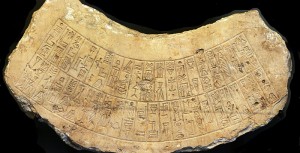
Summary of Military Organisation
- The individual soldier and the individual battlecart with its crew and team of 4 asses.
- Squad of 10 soldiers commanded by the Ugula.
- Squadron of 6 battle-carts?
- Company of 60 soldiers commanded by the Ugula-of-60.
- Brigade of 60 battlecarts.
- Brigade or regiment of 600 soldiers commanded by the Nubanda.
- Division of 5000 soldiers commanded by the Shagina.
- The whole army commanded by the Lugal.
Let us indulge in some speculation. In a hypothetical brigade of 600 soldiers it might have been possible to have:
- A company of 60 foot soldiers equipped as shield-bearers for the front rank.
- Six companies of 60 infantry spearmen armed with long spears in six rank columns.
- A company of 60 infantry skirmishers armed with javelins.
- A company of 60 infantry archers or slingers.
- A company of 60 infantry armed with the hefty Gamlu battle-axe, probably as the guard of the Nubanda.
- This formation might be supported by a squadron of 6 battle-carts.
Alternatively, if there were a brigade of 600 spearman, for example, such a formation would still need to operate in sub-units of 60 to march, deploy and avoid confusion in battle. Standards were used by the Sumerians and Akkadians, and may have been used at various levels of unit organisation. Certainly there was an army standard, and probably divisional and brigade standards as well. Drums are often mentioned in texts, usually in connection with rituals, but would be ideal to help drill and manoeuvre serried ranks, as well as inspiring dread as the spear formation advanced towards the foe.
View our full Early Bronze Age range of models:

